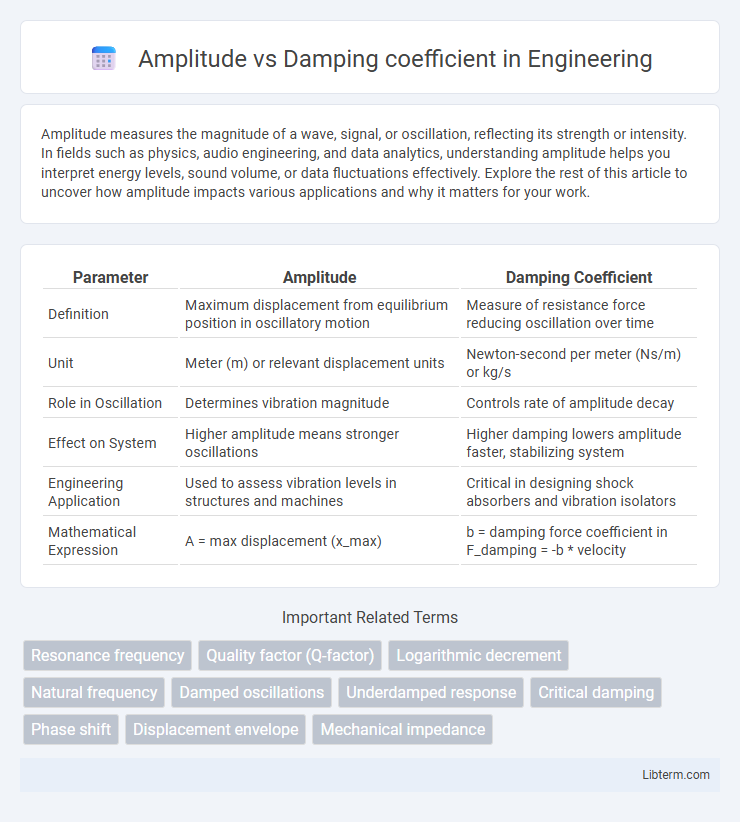Amplitude measures the magnitude of a wave, signal, or oscillation, reflecting its strength or intensity. In fields such as physics, audio engineering, and data analytics, understanding amplitude helps you interpret energy levels, sound volume, or data fluctuations effectively. Explore the rest of this article to uncover how amplitude impacts various applications and why it matters for your work.
Table of Comparison
| Parameter | Amplitude | Damping Coefficient |
|---|---|---|
| Definition | Maximum displacement from equilibrium position in oscillatory motion | Measure of resistance force reducing oscillation over time |
| Unit | Meter (m) or relevant displacement units | Newton-second per meter (Ns/m) or kg/s |
| Role in Oscillation | Determines vibration magnitude | Controls rate of amplitude decay |
| Effect on System | Higher amplitude means stronger oscillations | Higher damping lowers amplitude faster, stabilizing system |
| Engineering Application | Used to assess vibration levels in structures and machines | Critical in designing shock absorbers and vibration isolators |
| Mathematical Expression | A = max displacement (x_max) | b = damping force coefficient in F_damping = -b * velocity |
Introduction to Amplitude and Damping Coefficient
Amplitude represents the maximum displacement of a system from its equilibrium position during oscillation, reflecting the energy stored in the system. The damping coefficient quantifies the rate at which oscillatory motion loses energy due to resistive forces such as friction or air resistance. Understanding the interplay between amplitude and damping coefficient is crucial in analyzing the behavior of damped harmonic oscillators and predicting system response over time.
Defining Amplitude in Vibrational Systems
Amplitude in vibrational systems refers to the maximum displacement of an oscillating object from its equilibrium position, representing the peak value of vibration. The damping coefficient quantifies the rate at which the amplitude decreases over time due to energy loss from friction or resistance within the system. A higher damping coefficient results in a faster reduction of amplitude, critically affecting the stability and response of mechanical and structural systems.
Understanding the Damping Coefficient
The damping coefficient quantifies the resistance force opposing the motion in oscillatory systems, directly affecting the amplitude reduction over time. A higher damping coefficient results in a faster decrease in amplitude, leading to quicker stabilization of the system. Understanding this parameter is crucial for controlling vibration in mechanical structures and designing systems with desired oscillatory behavior.
Mathematical Relationship Between Amplitude and Damping
The amplitude \( A(t) \) of a damped harmonic oscillator decreases exponentially over time according to the relationship \( A(t) = A_0 e^{-\zeta \omega_n t} \), where \( A_0 \) is the initial amplitude, \( \zeta \) is the damping coefficient, and \( \omega_n \) is the natural angular frequency. The damping coefficient \( \zeta \) quantifies the rate of energy dissipation in the system and directly controls the amplitude decay rate, with higher \( \zeta \) values resulting in faster amplitude reduction. This exponential decay reflects the mathematical interplay between amplitude and damping in underdamped systems, as described by the differential equation governing damped oscillations.
Types of Damping: Underdamped, Overdamped, and Critically Damped
The relationship between amplitude and damping coefficient defines the system's damping type: underdamped systems exhibit oscillations with gradually decreasing amplitude, overdamped systems show a slow return to equilibrium without oscillations, and critically damped systems return to equilibrium as quickly as possible without oscillating. In underdamped scenarios, the amplitude decreases exponentially, reflecting low damping coefficients that allow oscillatory motion. Overdamped and critically damped cases involve higher damping coefficients that suppress oscillations, with the critically damped condition representing the precise damping level yielding the fastest amplitude decay without overshoot.
How Damping Coefficient Affects Amplitude
The damping coefficient directly influences the amplitude of oscillatory systems by controlling the rate at which energy dissipates during motion. Higher damping coefficients result in faster energy loss, causing the amplitude to decrease more quickly over time, leading to quicker attenuation of vibrations. Conversely, lower damping coefficients allow the system to maintain larger amplitudes for longer durations, sustaining oscillations with less energy loss.
Real-World Examples: Amplitude and Damping in Engineering
In engineering, the relationship between amplitude and damping coefficient is crucial for designing stable mechanical systems, such as automotive suspensions and building structures subjected to seismic activities. High damping coefficients reduce amplitude oscillations, preventing structural damage by dissipating energy efficiently during dynamic loads. For example, shock absorbers in vehicles use controlled damping to minimize amplitude of vibrations, improving ride comfort and vehicle stability.
Measurement and Calculation Methods
Amplitude measurement involves capturing the maximum displacement of oscillations, typically using sensors like accelerometers or laser displacement sensors for precise data acquisition. The damping coefficient is calculated by analyzing the rate of amplitude decay over time, often utilizing logarithmic decrement methods or curve fitting techniques on recorded oscillation data. Accurate measurement equipment and signal processing algorithms are essential for determining these parameters in mechanical and structural systems.
Practical Applications and Implications
Amplitude and damping coefficient critically influence the performance and stability of mechanical and electrical systems in practical applications. In engineering structures, high damping coefficients reduce amplitude rapidly, minimizing vibrations and preventing structural fatigue. Control of amplitude through optimized damping is essential in automotive suspensions, seismic dampers, and electronic filters to ensure safety, comfort, and signal integrity.
Summary: Key Differences Between Amplitude and Damping Coefficient
Amplitude measures the maximum displacement of a vibrating system from its equilibrium position, reflecting the energy or intensity of oscillations. The damping coefficient quantifies the rate at which oscillations decrease due to resistive forces, directly affecting the amplitude decay over time. While amplitude indicates oscillation size, the damping coefficient determines how quickly that amplitude reduces and influences the system's stability and energy dissipation.
Amplitude Infographic

 libterm.com
libterm.com